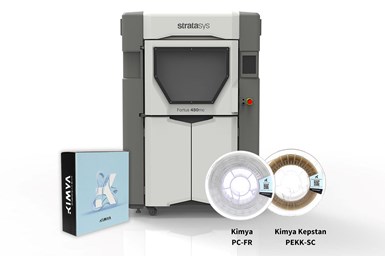Kimya Supplying Materials for Stratasys’ FDM Systems
Stratasys will offer customers two new materials from Kimya — EN45545–2 certified polycarbon filament (Kimya PC-FR) and a polyetherketone filament made from Arkema’s Kepstan (Kimya PEKK-SC).

Photo Credit: Kimya and Stratasys
Stratasys, a provider of polymer 3D printing solutions, has selected Kimya, an Armor company, to provide Stratasys-validated materials for its fused deposition modeling (FDM) technology-based systems, which were previously closed to third-party filaments. With the integration of Kimya into its ecosystem, Stratasys offers its customers a wider range of materials, greater flexibility and the ability to accelerate the adoption of additive manufacturing (AM) into their production processes.
Kimya is said to have expertise in custom 3D material formulation and the production of finished parts with utility value. Now, Kimya offers Stratasys’ industrial customers two new materials — EN45545–2 certified polycarbon filament (Kimya PC-FR) and a polyetherketone filament made from Arkema’s Kepstan (Kimya PEKK-SC). These two materials will be marketed from the second half of 2022 and will be used in particular in the rail and oil industries.
“We are expanding our ecosystem of materials to offer our customers a wide range of 3D printing technologies and solutions, while ensuring our customers maintain the utmost confidence in the performance of these filaments,” says Adam Pawloski, Stratasys vice president of manufacturing solutions. “That’s why we partner with excellent companies like Kimya, whose expertise in custom 3D material formulation includes the production of finished parts with use value.”
These initial materials begin what both companies say should be a long-term partnership to accelerate the adoption of AM at production scale. Stratasys and Kimya have also initiated an R&D program with the goal to bring new co-branded filaments to market by spring 2023. For example, Kimya is said to bring unique expertise in formulating recycled 3D materials that could be applied to the collaboration. Additionally, through the provision of a Stratasys open materials license, Kimya will have the opportunity to work directly on the printing parameters of Stratasys printers to develop new custom materials.
“Together, we will be able to offer manufacturers new innovative and high-performance materials capable of meeting an ever growing number of applications,” says Pierre-Antoine Pluvinage, Kimya business development director. “This partnership reflects our common vision of the market, which is to accelerate the transition of additive manufacturing to production scale through the creation of a strong ecosystem.”
Related Content
-
7 Takeaways on 3D Printing As a Pathway to Polymer’s Future
The Cleveland section of SPE hosted “Additive Manufacturing: Printing the Path for the Future” on October 17, 2024. Speakers signaled where AM is and where it is headed with session topics ranging from pellet-based 3D printing to qualification and commercialization of additively manufactured products.
-
Stratasys F3300 FDM 3D Printer Boosts Productivity, Print Reliability, Part Yield
The F3300 FDM 3D printer is built for performance-oriented manufacturers, expanding the range of production capabilities with improved accuracy, uptime and twice the output.
-
When Advocacy Leads to Adoption: How Pella Applies (and Manages) AM Capacity
The window and door maker offers a picture of successful, widespread 3D printing adoption across the different needs of a manufacturing organization. The outreach and education effort worked. Now, here is the next phase.













